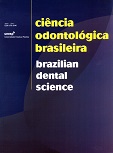Experimental candidosis on rat’s tongue
DOI:
https://doi.org/10.14295/bds.2004.v7i2.484Resumo
The purpose of this study was to evaluate the development of candidosis in rat’s tongue after intraepithelialinjections of Candida albicans. Fifty rats (Rattus norvegicus, Albinus, Wistar), originally negative for the Candidaspp. received ten intraepithelial injections of C. albicans on the dorsal tongue. Groups of five animals werekilled after 1, 2, 4, 6, 8, and 12 hours and 1, 2, 7, and 15 days after the injection. The rat’s tongues weresurgically removed and then macroscopic and microscopic analyses were performed. The development of candidosislesions was observed in all the rats studied. One hour after the injection, the development of germ tubesfrom the yeast cells could be observed. After 4 hours, Candida spp. pseudohyphae penetrated the epithelial cellswith the formation of microabscesses. After 24 to 48 hours, the epithelial areas with pseudohyphae invasionpresented desquamation, hyperplasia of the basal layer and discrete inflammation of the connective tissue. Afterseven days, few pseudohyphae could be observed. The epithelium presented acanthosis, hyperkeratosis and lossof filiform papillae. After 15 days, neither yeasts nor pseudohyphae were found. In some areas, the epitheliumpresented acanthosis and loss of filiform papillae. It can be concluded that the intraepithelial injection of Candidaalbicans on the dorsal rat tongue caused candidosis lesions in all the animals studied. C. albicans waspresent until seven days after the injections.Downloads
Downloads
Publicado
Como Citar
Edição
Seção
Licença
TRANSFERÊNCIA DE DIREITOS AUTORAIS E DECLARAÇÃO DE RESPONSABILIDADE
Toda a propriedade de direitos autorais do artigo "____________________________________________________________________" é transferido do autor(es) para a CIÊNCIA ODONTOLÓGICA BRASILEIRA, no caso do trabalho ser publicado. O artigo não foi publicado em outro lugar e não foi submetido simultaneamente para publicação em outra revista.
Vimos por meio deste, atestar que trabalho é original e não apresenta dados manipulados, fraude ou plágio. Fizemos contribuição científica significativa para o estudo e estamos cientes dos dados apresentados e de acordo com a versão final do artigo. Assumimos total responsabilidade pelos aspectos éticos do estudo.
Este texto deve ser impresso e assinado por todos os autores. A versão digitalizada deverá ser apresentada como arquivo suplementar durante o processo de submissão.




























